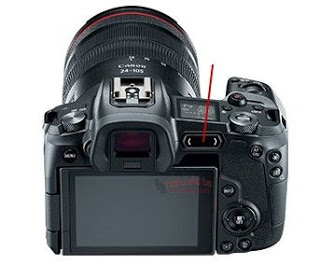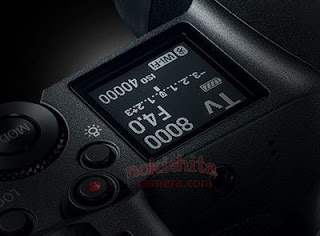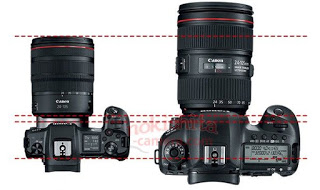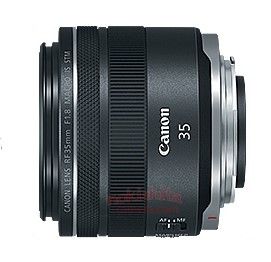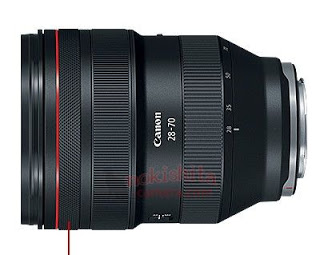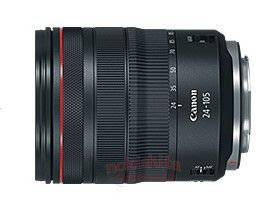EVOLUTION MEETS REVOLUTION AS CANON ANNOUNCES THE ALL-NEW EOS R SYSTEM
Optical Innovation Inspires the Next Leap Forward in Imaging
MELVILLE, N.Y., September 5, 2018 – Canon U.S.A. Inc., a leader in digital imaging solutions, today announced the next revolution in the company’s long history of innovative and award-winning camera systems, the EOS R system featuring the newly designed RF mount. Recognizing the need to advance optical design, the Company sought to create a versatile and powerful new system that supports all current EF, EF-S, TS-E and MP-E lenses[i], and also provides the optical advancements and engineering flexibility to build upon for years to come.
When Canon set forth to develop a new interchangeable lens camera system, they focused on three core optical principles: high-image quality, high-specification performance, and compact design. Recognizing that optics is the foundation for any camera system, the RF mount was conceived to open new doors in optical design. Canon’s new RF mount features the same size diameter as the EF mount (54mm) and shorter back focus distance. This allows for lenses to sit closer to the sensor (the focal plane) and allowed Canon optical engineers to reimagine lens design utilizing larger rear lens elements to produce an image on the full-frame sensor. This new optical formula has paved the way for higher performing lenses. In addition, the Canon RF mount features a high-speed 12-pin communication system that provides faster and more in-depth communication between the camera and lens over existing Canon mount systems.
The EOS R system is designed for full, uninhibited compatibility with all existing EF, EF-S, TS-E and MP-E lenses through the use of mount adapters[ii]. In addition, through the use of the optional Drop-In Filter Mount Adapter or Control Ring Mount Adapter these lenses, in fact, gain functionality.
“There has never been a time in history in which visual expression has been so prolific. Imaging, both still and video, are the communication mediums of today’s society. Much in the same way we learned to type in the past, today’s youth are skilled in shooting, editing, and visual storytelling in ways that only the masters of each craft were decades ago,” said Kazuto Ogawa, president and chief operating officer, Canon U.S.A., Inc. “Knowing this, we needed to step back and design a system that delivers all the creative expression and functionality today’s youth crave, now and in the years to come.”
The First in a New System: The EOS R
The new Canon EOS R full-frame mirrorless camera features a 30.3 megapixel CMOS sensor that is powered by the Company’s latest image processor, DIGIC 8, enabling shooting at up to 8.0 frames per second[iii]. The new camera inherits a lot from Canon’s legacy in both EOS and Cinema EOS. Video storytellers can capture stunning 4K UHD video up to 30fps and record in 10-bit 4:2:2 (with an external recorder). The EOS R also comes with the ability to shoot Canon Log, providing 12 stops of dynamic range, minimal loss of detail in shadows and highlighted areas and an increased range of choices when color grading. Users with an existing collection of Canon lenses will be excited to know that all EF and EF-S lens are compatible with the camera. In order to do so, photographers and videographers can choose between using one of three new mount adapters, each uniquely designed to meet the individual needs of the user.
The new Canon EOS R camera features Dual Pixel CMOS Auto Focus with 5,655 manually selectable AF points[iv], supporting AF at up to f/11 with a 384 zone (24x16) real-time metering system. With f/1.2 lenses, the camera astonishingly boasts AF sensitivity in low light in as little as EV-6. When using the RF 24-105mm F4 L IS USM lens with the EOS R, the camera can focus in as little as 0.05 seconds with Dual Pixel CMOS AF[v], making it the fastest autofocus speed in the world[vi]. These features provide photographers and videographers with Canon’s most advanced AF system to date. The EOS R also features a silent shutter setting when shooting in single-shot mode; an important feature for those who need to capture imagery without disrupting the scene. An upcoming free firmware update will enable silent shutter in continuous shooting mode as well.
“The EOS R system is not just a new camera or a new lens mount, it is a new design that will allow us to produce visual tools that were previously impossible, and allow our customers to tell their stories with greater depth, richness of color, and creative flexibility, in optically stunning ways.” states Kazuto Ogawa
Thoughts From the First Users
“I think every camera system has its place and it’s all about having the right tool for the job,” reported acclaimed outdoor photographer and Canon Explorer of Light Jimmy Chin. “The new EOS R system for me in particular is very useful for the kind of shooting that I do in the mountains, where I need to worry about the size and weight. Having the option to use the new RF lenses or the EF lenses is really great.”
“I was instantly impressed with how quickly the EOS R was able to focus,” remarked celebrated fashion photographer and Canon Explorer of Light Lindsay Adler. “Whether my subject was moving or I was shooting in near-complete darkness, I had no problem getting tack-sharp focus in every shot. It was a relief to know my gear wasn’t going to hold me back from executing my vision, but instead it would really help me to execute this vision.”
“For us, it's all about getting the shot no one else can get, and a lot of this has to do with the camera,” says Devin Graham, director and filmmaker behind YouTube’s DevinSuperTramp. “The new EOS R will become one of our main cameras. It has a very small footprint, yet is able to create amazing images. As for the lenses, the new RF 28-70mm F2 has just become one of my all-time favorites. I’ll be bringing it on every project.”
Conveniently placed just to the right of the EVF, Canon has introduced a new Multi-Function Bar that will allows users to more easily access their customizable settings, such as AF, ISO and White Balance. Users will have the option to either slide or tap the bar to gain access to the settings and adjust on-the-go as they deem necessary depending on each particular shooting situation.
Answering the demand for enhanced mobile editing of RAW image files, Canon is also announcing a new application, Digital Photo Professional Express (DPP Express). In combination with an updated Canon Camera Connect App, DPP Express enables users to send, view, edit and process CR3 RAW files on their iPad[vii]. A free download of the app will be available October 2018.
Additional noteworthy features of the EOS R Camera include:
- RF Mount Compatible with RF Lenses and EF/EF-S Lenses
- Built-in EVF with 3.69 Million Dots, Vari-angle Touchscreen LCD and Dot-matrix LCD Panel
- ISO range of 100-40,000, expandable to 102,400
- USB 3.1 in-camera charging support
- Built-in Bluetooth and Wi-Fi® providing easy sharing to compatible smart devices and social media sites
- Single UHS-II SD card slot
- CR3(RAW/C-RAW) and Dual Pixel RAW Support
- Dust and weather resistant
Availability and Pricing
The Canon EOS R full-frame mirrorless camera is scheduled to be available in October 2018 for an estimated retail price of $2299* for the body only. It will also be sold as a body-and-lens kit with the new RF 24-105mm F4 L IS USM lens for $3399*.
[i] When attaching an EF-S lens via any of Canon’s new R-series mount adapters, the new EOS R automatically switches to APS-C crop mode.
[ii] When attaching an EF-S lens via any of Canon’s new R-series mount adapters, the new EOS R automatically switches to APS-C crop mode.
[iii] Continuous shooting speed may vary depending on the shutter speed, the aperture, the lens being used, the battery charge and various camera settings.
[iv] Available AF points may decrease when shooting with AF cropping or in movie mode, or depending on camera settings or lens attached.
[v] Based on results of AF speed tests in accordance with CIPA guidelines. Results may vary depending on shooting conditions and lens in use. Relies on internal measurement method.
- Brightness at time of distance measurement: EV12(regular temperature, ISO 100)
- Shooting mode: M
- Lens in use: RF 24-105mm F4 L IS USM, with focal distance of 24mm and live-view mode on(with manual shutter button operation
- AF mode: Live single-point AF(central) and AF operation: One-shot AF
[vi] Among interchangeable lens digital mirrorless cameras incorporating 35mm full frame equivalent image sensors with phase-difference detection AF on the image plane and contrast detection AF, available in the market as of September 5th, 2018 (Based on Canon's Research).
[vii] Compatible with iPad models utilizing iOS 11 or later and equipped with at least 2GB of onboard RAM—specifically, iPad Pro (all models), iPad (5th generation), iPad (6th generation), iPad mini 4 and iPad Air 2.
*Availability, prices and specifications are subject to change without notice. Actual prices are set by individual dealers and may vary.
Canon EOS R specifications
Price
MSRP$2299 (body only), $3399 (w/24-105 F4L lens)
Body type
Body typeSLR-style mirrorless
Body materialMagnesium alloy
Sensor
Max resolution6720 x 4480
Other resolutions4176 x 2784 (1.6x crop)
Image ratio w:h1:1, 4:3, 3:2, 16:9
Effective pixels30 megapixels
Sensor photo detectors32 megapixels
Sensor sizeFull frame (36 x 24 mm)
Sensor typeCMOS
Color spacesRGB, Adobe RGB
Color filter arrayPrimary color filter
Image
ISOAuto, 100-40000 (expands to 50-102400)
Boosted ISO (minimum)50
Boosted ISO (maximum)102400
White balance presets6
Custom white balanceYes
Image stabilizationNo
Uncompressed formatRAW
JPEG quality levelsFine, normal
File format
- JPEG
- Raw (14-bit Canon CRW)
- C-Raw (Canon compressed Raw)
Optics & Focus
Autofocus
- Contrast Detect (sensor)
- Phase Detect
- Multi-area
- Center
- Selective single-point
- Tracking
- Single
- Continuous
- Touch
- Face Detection
- Live View
Autofocus assist lampYes
Manual focusYes
Number of focus points5655
Lens mountCanon RF
Focal length multiplier1×
Screen / viewfinder
Articulated LCDFully articulated
Screen size3.2″
Screen dots2,100,000
Touch screenYes
Screen typeTFT LCD
Live viewYes
Viewfinder typeElectronic
Viewfinder coverage100%
Viewfinder magnification0.76×
Viewfinder resolution3,690,000
Photography features
Minimum shutter speed30 sec
Maximum shutter speed1/8000 sec
Exposure modes
- Program
- Aperture priority
- Shutter priority
- Manual
Built-in flashNo
External flashYes (via hot shoe)
Flash X sync speed1/200 sec
Drive modes
- Single
- High-speed continuous
- Low-speed continuous
- Self-timer
Continuous drive8.0 fps
Self-timerYes (2 or 10 secs)
Metering modes
- Multi
- Center-weighted
- Spot
- Partial
Exposure compensation±3 (at 1/3 EV, 1/2 EV steps)
AE Bracketing±3 (3 frames at 1/3 EV, 1/2 EV steps)
Videography features
FormatMPEG-4, H.264
Modes
- 3840 x 2160 @ 30p / 480 Mbps, MOV, H.264, Linear PCM
- 3840 x 2160 @ 30p / 120 Mbps, MOV, H.264, AAC
- 3840 x 2160 @ 24p / 480 Mbps, MOV, H.264, Linear PCM
- 3840 x 2160 @ 24p / 120 Mbps, MOV, H.264, AAC
- 3840 x 2160 @ 23.98p / 480 Mbps, MOV, H.264, Linear PCM
- 3840 x 2160 @ 23.98p / 120 Mbps, MOV, H.264, AAC
- 1920 x 1080 @ 60p / 180 Mbps, MOV, H.264, Linear PCM
- 1920 x 1080 @ 60p / 60 Mbps, MOV, H.264, AAC
- 1920 x 1080 @ 30p / 90 Mbps, MOV, H.264, Linear PCM
- 1920 x 1080 @ 30p / 30 Mbps, MOV, H.264, AAC
- 1920 x 1080 @ 24p / 90 Mbps, MOV, H.264, Linear PCM
- 1920 x 1080 @ 24p / 30 Mbps, MOV, H.264, AAC
- 1920 x 1080 @ 23.98p / 90 Mbps, MOV, H.264, Linear PCM
- 1920 x 1080 @ 23.98p / 30 Mbps, MOV, H.264, AAC
- 1280 x 720 @ 120p / 160 Mbps, MOV, H.264, Linear PCM
MicrophoneStereo
SpeakerMono
Storage
Storage typesSD card (UHS-II supported)
Connectivity
USBUSB 3.1 Gen 1 (5 GBit/sec)
USB chargingYes (with LP-E6N only)
HDMIYes (Mini-HDMI)
Microphone portYes
Headphone portYes
WirelessBuilt-In
Wireless notes802.11b/g/n + Bluetooth 4.1 LE
Remote controlYes (via smartphone)
Physical
Environmentally sealedYes
BatteryBattery Pack
Battery descriptionLP-E6N lithium-ion battery & charger
Battery Life (CIPA)370
Weight (inc. batteries)660 g (1.46 lb / 23.28 oz)
Dimensions136 x 98 x 84 mm (5.35 x 3.86 x 3.31″)
Other features
Orientation sensorYes
GPSNone




